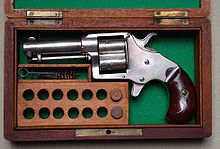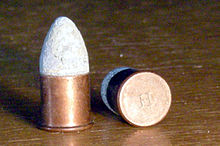Colt House 1871
The Colt House 1871 , also Colt's Patent House Pistol, was the first closed-frame cartridge revolver manufactured by Colt . There were 2 variants on the market, first the four-shot model, called the Cloverleaf, with a cloverleaf-shaped drum and later the five-shot model with a cylindrical drum, both for rimfire cartridges in .41 caliber.
history
After Rollin White's patent - the cylindrically pierced revolver drum and the associated use of prefabricated metal cartridges - expired in April 1869 , it was also possible for Colt to bring breech-loaders with pierced drums onto the market. In the beginning, these were based on the percussion models, as machines and components were available. Even before 1870, F. Alexander Thuer, an engineer at Colt, developed a revolver that fired metal cartridges (Thuer conversion). In this case, however, the cartridges were pushed into the drum from the front. After 1871, existing percussion revolvers were converted to rear loading , such as the Colt Conversion Revolver or, like the Colt Open Top, newly manufactured. The Richards-Conversion in caliber .44 was the successor to the Army 1860 and the Richards-Mason-Conversions were modifications of the Navy-Colts Mod. 1851, Mod. 1861 and the smaller models on pocket frames. In all conversions, the muzzle-loading drum was replaced with a pierced drum and the tap was modified. The larger models also have a loading flap and a case ejector.
The Colt Model 1871-72 .44 Open Top , which was produced in 7,000 copies in 1871/1872, was still based on the system box of the Colt Army 1860. Like the Conversions, it had a loading flap and a case ejector. In contrast to its predecessors, however, the visor was attached to the rear end of the barrel. This .44 Rimfire revolver was the direct predecessor of the Colt Single Action Army Model 1873 , which would become a legend of its own.
The first Colt breech loader with a closed frame, however, was the Colt House "Cloverleaf", this and the five-shot model were produced from 1871 to approx. 1875 and became the basis for the New Line Series that followed it.
The New Line series was a series of revolvers in smaller calibers and therefore also in a more compact format, so-called pocket pistols / revolvers. Colt placed a high value on quality in the manufacture of its weapons, which had an impact on the price. Many small armourers flooded the market with cheap products that were also poorly made. Colt, however, lost the price war against these products, which is also reflected in the low production numbers of the New Line series.
Structure of the weapon
The Colt Cloverleaf House was a .41 caliber, rimfire, four-shot revolver with a 7.4 cm (2 7/8 inch) barrel, rarely 1 1/2 ". It had a very distinctive drum that looked like four Tubes (for one cartridge each) were packed together, the appearance was strongly reminiscent of a clover leaf . Secured, the firing pin blocked the drum rotation between 2 chambers and the revolver was flatter. Like the later Colt models, the House was on the right side over a loading pit The cock was half cocked, the drum could rotate freely. Then you had to align the drum chamber and the loading pit exactly and then the cartridges could be inserted into the chamber. If the cock was fully cocked and the drum aligned with the barrel, this was the case Loading pit offset so that none of the cartridges could fall out. Between 1871 and 1876, the Colt House produced around 10,000 pieces, of which 7,500 had the four-shot clover att drum and the rest a five-part round drum.
The system case, the open trigger and the handle were very reminiscent of the Smith & Wesson models . However, the Cloverleaf model already had a case ejector typical of this model, which was omitted from the five-shot model for reasons of economy.
In addition to the Colt House .41, the small Colt Open Top Pocket .22 revolver was also launched on the market from 1871 . This seven-shot revolver fired .22 short and .22 long rimfire cartridges.
Further developments
The Colt House .41 and the Open Top .22 were followed by the Colt NEW LINE series. These revolvers had a bird's head handle and still had a loading pit, and the loading flap was also missing. The New Line series was produced from 1873 to 1884. There were versions for .22 and .30 rimfire cartridges and .32 .38 and .41 rim or center fire cartridges. The drum held 7 rounds on the .22 and 5 rounds on the larger models.
From 1880 the Colt House models were replaced by the Colt NEW HOUSE Revolver model with a 2 1/4 inch barrel (approx. 5.7 mm) in the centerfire calibers .32, .38 and .41 with a larger, flat-bottomed handle. The case ejector was missing here, the drum was removed for unloading and the cases could be ejected with the drum axis. In contrast to the earlier models, the Colt New House had a tailgate.
In 1882 the NEW POLICE variant was added. Most of these revolvers had a 2 1/4 inch barrel and were used as a pocket pistol. Revolvers with a barrel longer than 4 1/4 inches (10.8 cm) had an additional case ejector, which corresponded in construction to a smaller ejector of the Colt Single Action. This was missing from the short models. The New Police revolvers depicted a police officer and a gangster (Cop and Thug) on the handles below.
See also
literature
- Robert L. Wilson: Colt. An American Legend. The Official History of Colt Firearms from 1836 to the Present. Sesquicentennial edition. Artabras, New York NY 1985, ISBN 0-89660-011-4 .




